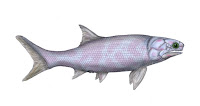The Best Way to Preserve a Beast - in Stone
THESE BONES NEED A HOME
BECOME A FUNDING CHAMPION
Click Here to Learn More
BECOME A FUNDING CHAMPION
Click Here to Learn More
Preserving a Beast
Rhizodonts were enigmatic ‘lobe-finned’ fish that grew up to 8 meters in length and weighed in at several tons. They were large ambush predators whose behaviour and feeding strategy was much the same as that of today’s crocodiles. These huge fish could crawl on their powerful front fins, gulping air into primitive lungs and even, presumably, would chase its prey onshore. This remarkable feat doesn’t seem so surprising when one looks at the skeletons of their fins. Rhizodonts possessed arm bones.
Rhizodont cleithrum (left) and clavicle (above)
Rhizodonts have recently been resolved as 'basal members of the Tetrapodomorpha’ which means changing towards four-leggedness. They were part of the evolutionary history of vertebrates when land-animals separated from their fish-ancestors. From fins into limbs – they’re the start of the movement. But, because of poor preservation paleontologists still know very little about this group of fishes than they do about any other lobe-finned group.
The idea that lobe-finned fishes were occasionally using their pectoral-fins to ‘crawl’ has long been accepted because of the obvious limb-like structure of their fins. However, theories about ancient crawling behavior based solely on features of the fins never managed to make it past the theoretical stage. 

Now, in some recognized rhizodont-trails here at Blue Beach (Nova Scotia), we have the long-awaited evidence of ‘crawling behaviour’ of the lobe-fin fish! We've identified numerous fin-imprints, belly-resting prints and tail-drags which are preserved on several conspicuous layers that represent ancient mudflats. More than one set of these fin-impressions form continuous trails; one has an apparent length of over 50 meters.
The first large and very impressive fin-print discovered in the early 1960’s; it was later described as the track of a large amphibian. It is now believed otherwise; we here at Blue Beach regard this giant trackway to be a trail of the big fish preserved in stone.
~~~~~~~~~~~~~~~~~~~~~~~~~~~~~~~~~~~~~~~~~~~~~~~~~~~~~~~
Contact Us / Ask How / Become a Funding Champion
You Can Help Build a 'Paleo-Centre' at Blue Beach, Nova Scotia
Email us: bbfmsfundraising@xplornet.com (copy & paste)
Check out our Website: Blue Beach Fossil Museum
Check out our Website: Blue Beach Fossil Museum








Comments
Post a Comment